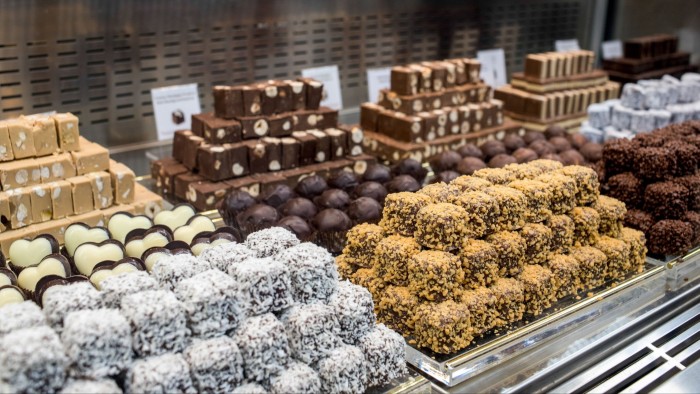Chocolate makers have slashed their use of hedges against price rises due to the soaring cost of futures contracts, in a bet that the huge bull market in cocoa is finally over.
Manufacturers typically use the futures market to hedge against price fluctuations, securing long-term contracts to lock in a set level. But surging cocoa prices have triggered big rises in the cost of hedging on major exchanges.
As a result, commercial long positions — in effect, hedges by manufacturers against input prices rising even higher — on the cocoa futures market in London have fallen to a 20-year low in recent weeks. There has also been a sharp drop in the total number of outstanding futures contracts in both London and New York.
Instead, some chocolate companies have started purchasing beans on a short-term basis in the hope that prices — which have already come down from more than £10,000 a tonne in December to slightly less than £6,500 — will continue to fall.
Other groups have switched to over-the-counter insurance products offered by banks to protect against price moves. Unlike futures bets, these have fixed costs that can be unappealing in normal times, but are more attractive when futures prices are spiralling to prohibitive levels.
“Ultimately, if you think the price is too high, you might as well wait and see,” said Daniele Ferrero, chief executive of Italian chocolatier Venchi.
Venchi’s cocoa supply is covered as the company hedged against prices rising last September. But “if you were asking me today to buy cocoa, I would buy it month by month,” Ferrero said.
Cocoa prices rocketed from about £3,500 at the start of last year to more than £10,200 in April of that year, as extreme weather and disease hit harvests in Ivory Coast and Ghana, which together produce nearly two-thirds of the world’s supply. Prices fell back below £5,000 by the autumn, before rallying again into the end of the year.
The price surge has hit consumers. Chocolate in the UK cost 13.6 per cent more this Easter than the same time last year, according to data from the UK’s Office for National Statistics, analysed by the Energy & Climate Intelligence Unit.

As cocoa prices soared throughout 2024, hedging helped shield consumers from much of the price rises, according to Warren Patterson, head of commodities strategy for ING.
“We saw prices breaking above £10,000 per tonne, yet the demand hit we saw was maybe not as aggressive as many would have thought,” he said. “Part of that is because of hedging.
“If you’re a chocolate manufacturer and you’ve hedged your exposure, you’re somewhat protected from those higher prices. You don’t have to pass those higher prices on to consumers because of those hedges.”
However, some chocolate producers have stopped hedging because of the skyrocketing cost of the upfront capital — the initial margin — needed to enter a futures contract.

These margin rates are now four to five times higher than they were when the markets were more stable and prices were lower, according to Jonathan Parkman, co-head of agriculture at commodity broker Marex.
“Prices went up so much more than most commercial players expected,” he said. “And that put a huge strain on their capability of financing those forward hedges.
“You need an awful lot more money in order to be able to operate in the same sort of fashion that you were operating before.”
The number of outstanding contracts in the cocoa futures market in London has “fallen off a cliff” because of these costs, added ING’s Patterson.
Coffee producers also sharply reduced their hedges in the futures market, although very recently some have started to put them on again.
Prices for higher-quality arabica beans reached a record of about $4.40 a pound in February, having surged due to poor weather in producer countries such as Brazil and Vietnam, which has crimped supplies. Prices have since fallen back but are still well above levels a year ago.

Starbucks slashed its hedging against coffee price fluctuations last year. It held less than $200mn worth of fixed-price contracts for unroasted coffee at the end of last September, according to its annual report, down from $1bn in 2019.
“Everyone in the industry is just covering the short period that you need for the next three months of production,” Antonio Baravalle, chief executive of Italian coffee roaster Lavazza, told the Financial Times.
“Considering where prices are, coverage on a longer period, it’s a big bet, it’s a big risk,” he said. Sooner or later prices have to fall “because it’s not manageable any more”.
Cutting hedges is “not necessarily a bad thing”, Parkman added. “If prices fall, it’s a good thing.”
Additional reporting by Madeleine Speed




